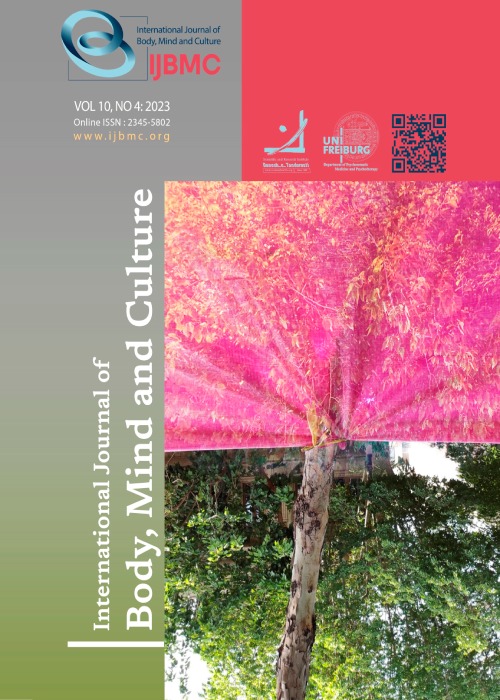فهرست مطالب

International Journal of Body, Mind and Culture
Volume:8 Issue: 1, Winter 2021
- تاریخ انتشار: 1399/11/27
- تعداد عناوین: 8
-
Pages 7-13Background
In Iran, there is a significant increase in women living with HIV+/AIDS. In a cultural, social, and political context, educational and empowerment needs are still considered a challenging issue among these women. The purpose of this qualitative study was to examine the experience of living with HIV+/AIDS from the perspective of women in Ahvaz, Iran, focusing on educational needs and empowerment.
MethodsThe present qualitative study was a descriptive phenomenology conducted in 2020. The research context included all educational, therapeutic, counseling, and support centers, governmental and non-governmental HIV/AIDS associations and institutions located in Ahvaz. The statistical population of the study included all women with HIV and AIDS. The study participants were selected using purposeful and snowball sampling method. Semi-structured open interviews (individual and face-to-face) were selected as the primary and central approach to data collection.
ResultsThe findings showed that the 5 identified themes of understanding the experience of focusing on educational needs and empowerment in women were severe suffering (shock, anger, resentment of the family and friends, and feelings of isolation), disapproval (prejudices, stereotypes, and taboos related to HIV in society, and feeling of lack of social support), insecurity in social and economic life (lack of readiness for cultural and social participation, equality or inequality in empowerment, assessing relationships based on economic criteria, and doubts about improving health), disrespect (disrespect for unique characteristics, and insult and slander), and hardship in protection (continuing to control health status information).
ConclusionIt can be concluded that the educational and empowerment needs of patients with AIDS/HIV+ should be taken into consideration. Mobilizing individuals, specialists, and providers of counseling and care services in different sectors to gain a better understanding of the complex nature of the phenomenon of non-compliance with the right to empowerment will be useful.
-
Pages 14-30
The concept of sexual justice is associated with the contentment of couples in their sexual life. In the present study, the obstacles of as well as the approaches to achieving sexual justice have been investigated. This study was carried out qualitatively through the thematic analysis of semi-structured in-depth interviews with sociologists, psychologists, and sexologists using ATLAS.ti software. The consequences of sexual injustice were determined at a macro level (reproduction of unequal relationships), meso level (disruption of relationships between individuals even at the family level), and micro level (lack of pleasure in sexual relationships, negative psychological background, sense of insecurity, development of stressful relationships, sense of aggression, and depression). Moreover, the obstacles to achieving sexual justice were classified and explained from the structural, institutional, individual, and action-reaction points of view.
-
Pages 31-39Background
Personality characteristics can be used to predict a person's behavior in various life situations, including marriage. This study was conducted to investigate the mediating role of psychosomatic symptoms in the relationship between personality characteristics and marital conflicts.
MethodsThe present descriptive correlational study was performed on all conflicting couples referring to the counseling centers in Mashhad, Iran, in 2018. The sample included 200 conflicting couples referring to the thought and behavior counseling centers in Mashhad selected using convenience sampling method. Cattell’s Sixteen Personality Factor (16PF) Questionnaire, Takata and Sakata’s Psychosomatic Complaints Scale, and the Marital Conflict Questionnaire were used to collect data. Data were analyzed using Pearson correlation coefficient and path analysis in SPSS and LISREL software.
ResultsThe results showed that personality characteristics can be used to predict a person's behavior in various life situations including marriage, and that there was a significant relationship between personality characteristics and marital conflicts (P < 0.01).
ConclusionIt can be concluded that psychosomatic symptoms have a mediating role in the relationship between personality characteristics and marital conflicts.
Keywords: Family Conflict, Psychophysiologic Disorders, Big Five Personality -
Pages 40-54Background
Many treatments make the life of coronary heart patients longer, but they require more psychosocial and spiritual support for a meaningful life. The aim of the present study was to determine the effect of a bioenergy economy (BBE)-based psycho-education package on improvement of vegetative function, forgiveness, and quality of life (QOL) of patients with coronary heart disease (CHD).
MethodsIn this clinical trial, using convenient sampling, 40 patients were selected from among patients referring to Bohlool Hospital in Gonabad, Iran, and were randomly assigned to the 2 case and control groups. First, the vegetative function checklist, Forgiveness Likelihood Scale, and World Health Organization Quality of Life (WHOQOL)-BREF questionnaire were completed for all the participants. Then, the case group received 8 sessions of group training for 180 minutes. After the training and the 1-month follow-up, both groups completed the questionnaires again. Finally, all data were analyzed using repeated measures analysis of variance (ANOVA) in SPSS software.
ResultsThe results showed a significant difference in heart rate, forgiveness, and QOL and its physical and psychological dimensions between the case group and control group after training (P < 0.05). The post hoc test showed that heart rate decreased significantly in the posttest compared to the pretest and forgiveness, and QOL and its physical and psychological dimensions increased significantly (P < 0.05). However, heart rate increased significantly in the follow-up compared to the posttest and forgiveness, and QOL and its physical and psychological dimensions decreased significantly (P < 0.05).
ConclusionIt can be concluded that group education based on BEE as a complementary care system was effective on heart rate, forgiveness, and QOL and its physical and psychological dimensions.
-
Pages 55-64Background
Cancer is one of the main and basic dilemmas of health and treatment all around the world. The purpose of this study was the comparison of the effectiveness of cognitive-behavioral therapy (CBT) and acceptance and commitment therapy (ACT) on anxiety, perceived stress, and pain coping strategies in patients with cancer.
MethodsThe methodology of the current study was of practical, semi-experimental, and pretest-posttest design with a control group. The statistical population of this study included all patients with leukemia who were hospitalized between April and June 2019 in Sayed Al Shohada Hospital, Isfahan, Iran, and their disease was confirmed. The study sample included 45 people who were selected from the mentioned population using convenience sampling and were assigned to the 3 groups of ACT (n = 15), CBT (n = 15), and control group (n =15) through simple randomization method. Data were collected using the Perceived Stress Scale (PSS) (Cohen et al., 1994), Beck Anxiety Inventory (BAI) (Beck et al., 1991), and Coping Strategy Questionnaire (CSQ) (Rosenstiel and Keefe, 1985). Data analysis was conducted using analysis of covariance (ANCOVA) in SPSS software.
ResultsThe results showed that CBT and ACT were effective on decreasing anxiety and perceived stress, and increasing pain coping strategies in patients with cancer. ACT was more effective than CBT on anxiety, perceived stress, and pain coping strategies.
ConclusionIt can be concluded that CBT and ACT are effective on anxiety, perceived stress, and pain coping strategies and can be used for patients with cancer.
-
Pages 65-74Background
Acceptance and commitment therapy (ACT) is one of the evidence-based therapies for chronic pain. One of the measuring tools used in this approach is the Chronic Pain Acceptance Questionnaire (CPAQ). The aim of the present study was to determine the psychometric properties of the CPAQ in a sample of patients with chronic pain in Isfahan, Tehran, and Yazd, Iran.
MethodsThis was a cross-sectional, methodological study. The statistical population included all Iranian patients with chronic pain. The sample consisted of 228 patients with chronic pain; the patients were simultaneously selected from medical centers affiliated to Isfahan University of Medical Sciences, Baqiyatallah Hospital in Tehran, and the Medical Clinics in Yazd. To determine the validity of the CPAQ, the Pain Disability Index (PDI), Pain Catastrophizing Scale (PCS), Pain Anxiety Syndrome Scale (PASS-20), and Satisfaction with Life Scale (SWLS) were used. SPSS software and correlation analysis methods, confirmatory factor analysis, and Cronbach's alpha were used.
ResultsThe reliability of the CPAQ was determined to be 0.79 using Cronbach's alpha method, and its validity was confirmed through inverse correlation with the scores of the PDI (-0.319), PCS (-0.228), PASS (-0.355), and SWLS (0.19); all correlation coefficients were significant (P < 0.01).
ConclusionThe validity and reliability of the CPAQ in Iranian patients with chronic pain have been confirmed. Thus, it can be used as a research tool for the measurement of acceptance index and commitment therapy outcome in Iranian patients.


